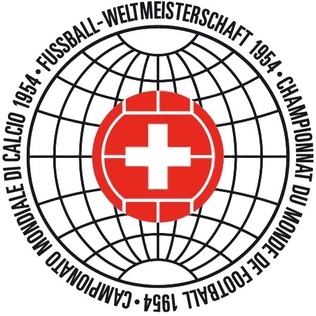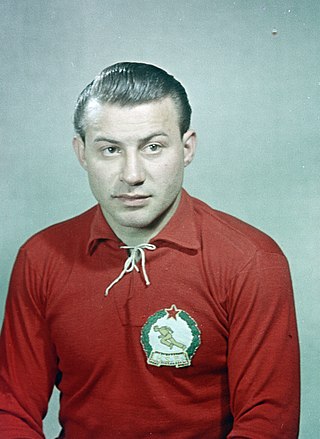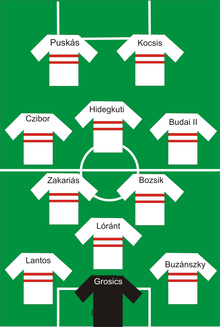
The 1954 FIFA World Cup was the 5th edition of the FIFA World Cup, the quadrennial international football tournament for senior men's national teams of the nations affiliated to FIFA. It was held in Switzerland from 16 June to 4 July. Switzerland was selected as the host country in July 1946. At the tournament, several all-time records for goal-scoring were set, including the highest average number of goals scored per game. The tournament was won by West Germany, who defeated tournament favourites Hungary 3–2 in the final for their first World Cup title. Uruguay the defending champions were eliminated by Hungary and would lose to Austria in the third-place match.

Ferenc Puskás was a Hungarian footballer and manager, widely regarded as one of the greatest players of all time and the sport's first international superstar. A forward and an attacking midfielder, he scored 84 goals in 85 international matches for Hungary and later played four international matches for Spain as well. He became an Olympic champion in 1952 and led his nation to the final of the 1954 World Cup. He won three European Cups, ten national championships and eight top individual scoring honors. Known as the "Galloping Major", in 1995, he was recognized as the greatest top division scorer of the 20th century by the IFFHS. Scoring 806 goals in 793 official games during his career, he is the seventh top goal scorer of all time by the RSSSF.

The Hungary national football team represents Hungary in men's international football, and is controlled by the Hungarian Football Federation. The team has made nine appearances in the FIFA World Cup, and five in the UEFA European Championship. Hungary plays their home matches at the Puskás Aréna, in Budapest, which opened in November 2019.
The Battle of Berne was a football match at the 1954 World Cup between Hungary and Brazil, a quarter-final played on 27 June 1954 at the Wankdorf Stadium in Bern, Switzerland. Violent conduct and fighting prompted English referee Arthur Ellis to send off three players during the match. Fighting between the teams continued in the dressing rooms after the final whistle.

Nándor Hidegkuti was a Hungarian football player and manager. He played as a forward or attacking midfielder and spent the majority of his playing career at MTK Hungária FC. During the 1950s he was also a key member of the Hungary national team team known as the Golden Team. Other members of the team included Ferenc Puskás, Zoltán Czibor, Sándor Kocsis and József Bozsik. In 1953, playing as a deep lying centre-forward, a position which has retroactively been compared to the modern false 9 role, he scored a hat-trick for Hungary when they beat England 6–3 at Wembley Stadium. Playing from deep, Hidegkuti was able to distribute the ball to the other attackers and cause considerable confusion to defences. This was an innovation at the time and revolutionised the way the game was played.

Sándor Péter Kocsis was a Hungarian footballer who played for Ferencvárosi TC, Budapest Honvéd, Young Fellows Zürich, FC Barcelona and Hungary as a striker. During the 1950s, along with Ferenc Puskás, Zoltán Czibor, József Bozsik and Nándor Hidegkuti, he was a member of the Mighty Magyars. After the 1956 Hungarian Revolution, he moved to Spain where he became a member of the FC Barcelona team of the late 1950s.
On 25 November 1953, Hungary – then the Olympic champions and on a run of 24 unbeaten games, and England, hailing from the birthplace of football, played a game which became known as the Match of the Century. Hungary won 6–3 and the result led to a review of the training and tactics used by the England team, and adoption of continental practices at international and club level in the English game.

Gusztáv Sebes was a Hungarian footballer, who played as a midfielder, and became a well-known coach later. With the title of Deputy Minister of Sport, he coached the Hungarian team known as the Mighty Magyars in the 1950s. Among the players in the team were Ferenc Puskás, Zoltán Czibor, Sándor Kocsis, József Bozsik, and Nándor Hidegkuti. Together with Béla Guttmann and Márton Bukovi, he formed a triumvirate of radical Hungarian coaches who pioneered the 4–2–4 formation.

Márton Bukovi was a Hungarian association football player and manager. After playing for Ferencvárosi TC, FC Sète and Hungary, he became a coach, most notably with Građanski Zagreb, MTK Hungária and the Hungary national team. Together with Béla Guttmann and Gusztáv Sebes, he formed a trio of innovative Hungarian coaches who pioneered the 4–2–4 formation.
The European International Cup of Nations was an international football competition held by certain national teams from Central Europe & South Europe between 1927 and 1960. There were competitions for professional and amateur teams. Participating nations were: Italy, Austria, Czechoslovakia, Hungary, Switzerland, Poland, Romania, and Yugoslavia. Poland and Romania only competed in the amateur competition.

The 1954 FIFA World Cup final was the final match of the 1954 FIFA World Cup, the fifth World Cup in FIFA history. The game was played at the Wankdorf Stadium in Bern, Switzerland, on 4 July 1954, and saw West Germany beat the heavily favoured Golden Team of Hungary 3–2. Earlier in the group stage, Hungary had defeated West Germany 8–3.

Zoltán Czibor was a Hungarian footballer who played for several Hungarian clubs, including Ferencváros and Budapest Honvéd, and the Hungary national team before joining CF Barcelona. Czibor played as a left-winger or striker and was notable for having a powerful shot, good pace and excellent ball control. During the 1950s he was part of the Magical Magyars, reaching the World Cup final with them in 1954. After the 1956 Hungarian Revolution he moved to Spain where he became a prominent member of the successful FC Barcelona team of the late 1950s. After three seasons at Barcelona, he joined their local rivals Español for the 1961–62 season. After brief spells at FC Basel, Austria Wien and Primo Hamilton FC, he retired as a professional footballer and returned to Hungary. He died there in 1997, aged 68.

Gyula Lóránt was a Hungarian footballer and manager of Croatian descent. He played as a defender and midfielder for, among others, UTA Arad, Vasas SC, Honvéd and Hungary.

László Budai, also known as László Bednarik, or Budai II, was a former Hungarian footballer and coach. Budai was born in Budapest and played as a midfielder and forward for Ferencvárosi TC, Honvéd and Hungary. During the 1950s he was a member of the legendary Hungarian national team known as the Mighty Magyars. Other members of the team included Ferenc Puskás, Zoltán Czibor, Sándor Kocsis, József Bozsik and Nándor Hidegkuti. The stadium of Rákospalotai EAC was named after him.

Mihály Lantos was a Hungarian football player and manager. He played as a defender, spending the majority of his career at MTK Hungária FC. During the 1950s he was also a member of the Hungary team known as the Golden Team. Other members of the team included Nándor Hidegkuti, Ferenc Puskás, Zoltán Czibor, Sándor Kocsis and József Bozsik. After retiring as a player Lantos worked as coach. Between 1965 and 1967 he was assistant coach to his former MTK manager, Márton Bukovi, at Olympiacos. He then returned to Hungary where he managed several teams including Videoton FC.
Péter Palotás, born as Péter Poteleczky, was a Hungarian footballer who played as a forward for MTK Budapest FC and Hungary. During the 1950s he was a fringe member of the team known as the Mighty Magyars and played alongside the likes of Ferenc Puskás, Zoltán Czibor, Sándor Kocsis, Nándor Hidegkuti and József Bozsik. Palotás was an early pioneer of the deep-lying centre-forward role and in 1955 he scored the first ever hat-trick in a European Cup game. In 1959 he retired as a player due to a heart condition. The same condition led to his death on 17 May 1967.

Jenő Kalmár, also referred to as János Kalmar or Kálmár Jenő, was a former Hungarian footballer and coach. As a player, Kalmar played for both MTK Hungária FC and Hungary. During the 1928-29 season he finished as top goalscorer for MTK, scoring 20 goals.
Football is the most popular sport in Hungary. The Hungarian Football Federation is the highest body of professional football in Hungary and was founded in 1901. The Hungary national team has played in numerous international tournaments, including the inaugural football tournament in the Olympic Games, nine World Cups, and four European Championships. Their greatest achievements are the three gold medals in the 1952, 1964 and 1968 Olympic Games, and the runner-up in the 1938 and 1954 World Cups. The team known as the Mighty Magyars was also the first non-British team to defeat England, 6–3 at Wembley in 1953. Months later, they defeated the English by a convincing 7–1 in Budapest in 1954, the worst defeat in the history of the English team.
Hungary v England (1954) was an international football game played on 23 May 1954. The game was played between the Hungary national football team—then the world's number one ranked team and the Olympic champions—and the England national football team, hailing from the birthplace of the game of football and reputed "Kings of Football". The game was a return fixture from the 1953 game in the old Wembley Stadium, where Hungary had beaten England 6–3.
Budapest Honvéd Football Club is a professional football club based in Budapest, Hungary.



















